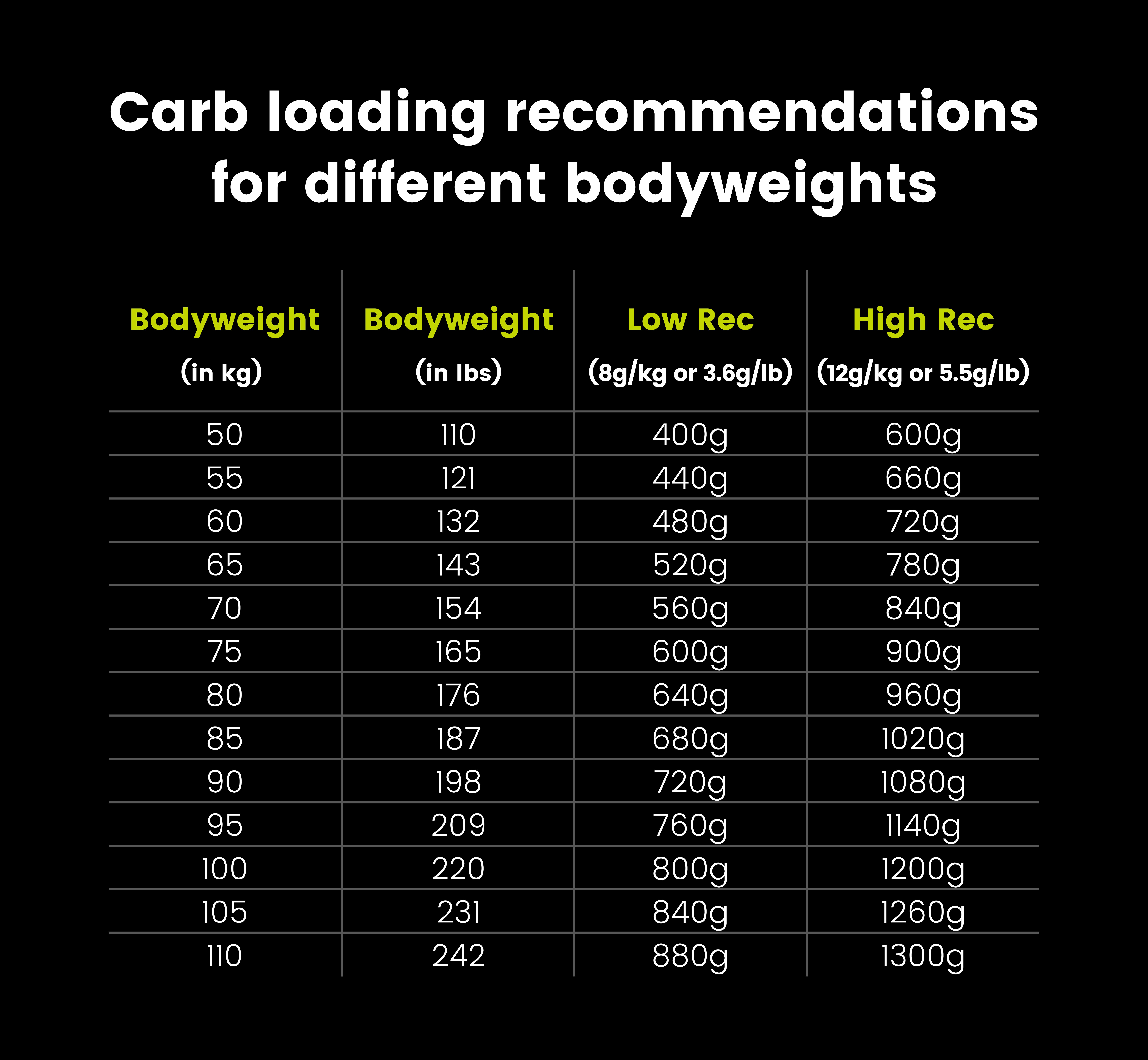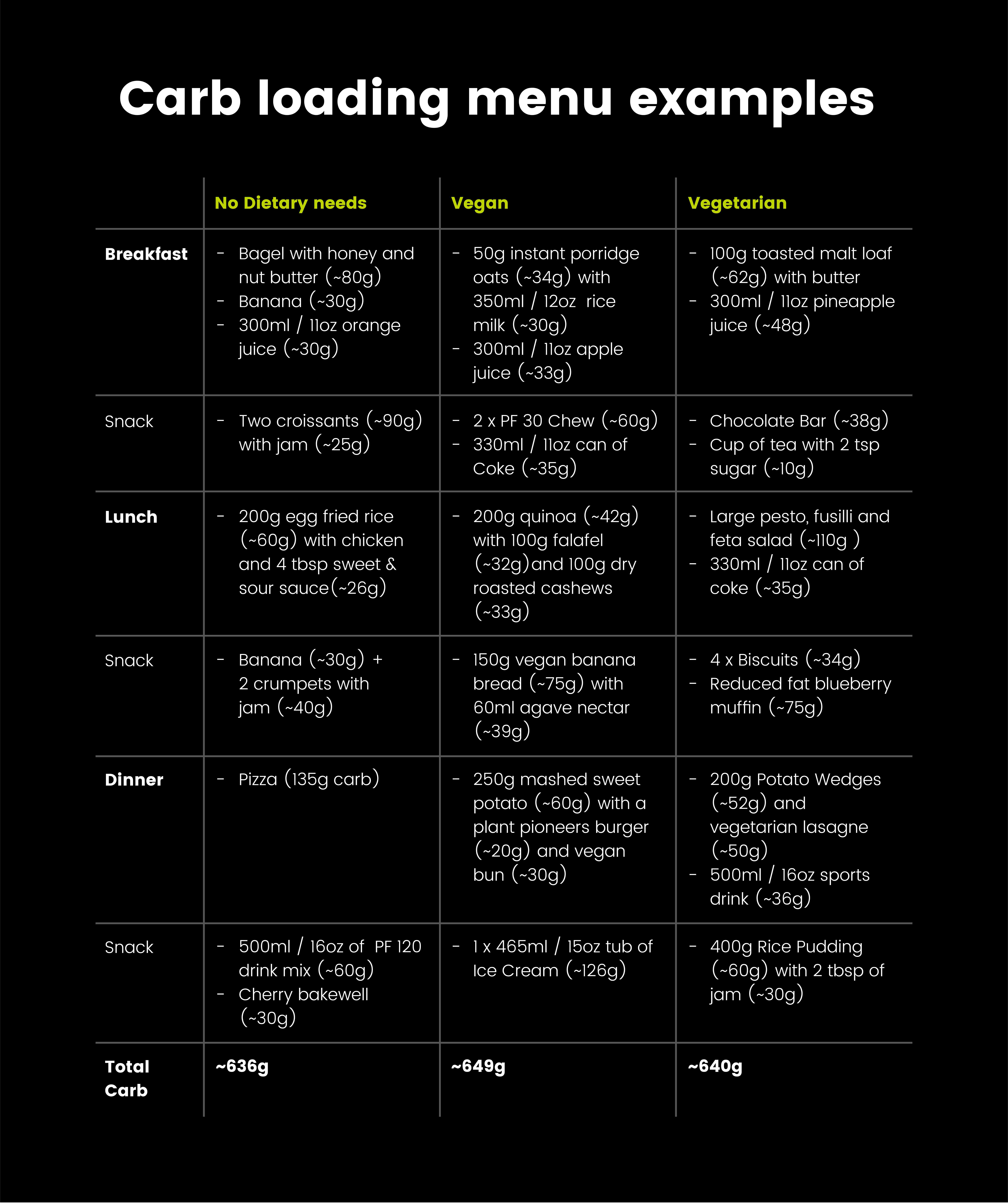There are five main considerations when it comes to an effective fueling and hydration strategy for UltraSwim 33.3.
- How to carb-load before UltraSwim 33.3
- How to start properly hydrated
- How to fuel and hydrate during each swim
- What should you eat and drink between each swim?
- Choosing the right foods after each swim
Let's take a look at how you can refine your approach to each of these aspects ahead of your UltraSwim 33.3...
How to carb-load before UltraSwim 33.3
Swimming, especially in cool or cold water, burns a lot of energy and most of this energy comes from carbohydrates.
Glycogen is the storage form of carbohydrate in the body and it is found in the liver (from where it’s converted to glucose to top-up blood sugar levels) and in the muscles where it is used to fuel muscular contraction.
If you’re well fed, you’ll usually have enough glycogen on board to power ~90 minutes of hard exercise. For exercise lasting beyond 90 minutes, taking some extra carbs in (usually via drinks or energy gels) is required to maintain your pace in any endurance event.
It’s possible to ‘super-compensate’ your glycogen stores (i.e. ‘overstock’ them) if you are suitably aggressive with carb intake in the final 24 hours before an event. This carb-loading technique is a common performance enhancing technique used by athletes and would be highly recommended before Day 1 of UltraSwim 33.3.
To carb-load effectively you will need to take in 8-12g of carbohydrate per kilogram of bodyweight in the final day before the event begins. This is a serious amount of eating so requires a plan and commitment to getting it done, but the benefits can be significant.
This table shows the total amount of carbohydrate needed for swimmers of different bodyweights:

And this is an example of what a carb-loading menu might look like for swimmers of different bodyweights:

You may have noticed that the majority of the foods listed in the carb-loading menu are simple or refined carbohydrates (i.e. the kind of foods often regarded as ‘unhealthy’). This is deliberate as these foods are easy to digest and contain little fibre. So, it’s easier to consume a large amount of carb-based calories whilst not working your digestive system too hard, which reduces the chances of an upset stomach on race day.
Practice carb-loading in the days prior to a couple of your biggest training swims to refine what you are going to eat before the race. Plan ahead to make sure you can buy or access your preferred carb-loading menu when you get to the event and travel with foods you need if in any doubt.
For a more in-depth look at the theory and practice of carb-loading, check out this article.
Start properly hydrated
Starting any endurance event well hydrated is clearly desirable given that even relatively mild dehydration can significantly impair performance.
Unlike carb-loading, you can’t ‘super-compensate’ with water and load up in the days prior. In fact, over-drinking plain water is potentially dangerous as it can result in diluting your blood electrolyte levels (a condition called hyponatremia), so moderation is key and drinking gallons of extra fluid is not a good idea.
One tactic you can employ to slightly boost your hydration status for a short period of time is to ‘preload’ with a strong electrolyte drink in the immediate build up to an event.
This involves drinking around 500ml (~16oz) of water containing a very strong electrolyte mix (PH 1500 is ideal for this) about 60-90 minutes before the start. The high level of sodium in the drink helps your body absorb and, more importantly, retain the fluid in your bloodstream, so that you have increased blood volume when you get started. Preloading before each stage at UltraSwim 33.3 is definitely recommended.
In addition to preloading, adding some additional salt (to taste) to your food in the last 2-3 days before the event and continuing to do so throughout the course of the event is a good idea to ensure that your sodium levels remain topped up.
For more information on the science behind preloading, check this article out.
How to fuel and hydrate during each swim
Eating and drinking whilst swimming is notoriously difficult for obvious reasons. However, doing so in a long event such as UltraSwim 33.3 is very sensible because seconds lost to stop to consume carbs and fluids at a feed station can be gained back with interest later on because properly fuelling ensures you don’t subsequently lose minutes by running out of gas later on.
One of the biggest advantages you’ll get from fuelling adequately during each swim is the ability to keep your work-rate up in the latter stages when slowing down and getting cold can present a vicious downward spiral, making it tough to finish. Plan to start fuelling early and prioritise it each hour to give yourself the best chance of finishing each stage in the best possible shape.
We’d recommend taking at least one energy gel (~30g of carb) or equivalent per hour spent in the water on each swim, and more if you are able to.
This should increase to two gels (~60g of carb) per hour if you’re going to spend more than three hours swimming on any of the longer stages and/or if you’re someone who really suffers in the cold.
Gels are a great option for fuelling as they can easily be carried in a tow-float, in your costume or wetsuit (practice in training required.
PF 30 Gels will be provided at all of the in-stage feed stations so that you can access more energy at key points during the swims.
Whilst it may be possible to complete some of the swims without consuming anything at all, it is strongly recommended that you do take some energy and/or fluids with carbs in during each stage. This is because glycogen depletion (i.e. running out of stored energy) can easily happen over the course of several stages, meaning that calories you take in during one swim will help you in the next one, even if you’d have completed the first without blowing up anyway.
In terms of hydration, if you preload properly and start each swim adequately hydrated, drinking is almost always going to be of secondary importance to getting enough carbs in. That being said, if the water temperature is on the higher end of what’s expected and you’re wearing a wetsuit, it is possible that you’ll sweat quite a lot if you’re working hard.
Practice your in-swim fuelling and hydration extensively during training swims in the build-up to the event. This is a crucial area that you don’t want to be learning on race day.
What should you eat and drink between each swim?
The main aim of your fuelling and hydration strategy between swims is to refill glycogen stores and to bring hydration levels back up to normal.
Simple and refined sources of carbohydrate (sports drinks, more gels or energy chews and other ‘sweet’ foods) are predominantly what you need to consume in the first 30-40 minutes after finishing. This is because your muscles are somewhat more receptive to absorbing carbs immediately post-exercise, so it’s important to try to take advantage of this ‘window of opportunity’ to kick-start the recovery process.
Aim for about 1g of carb per kilogram of bodyweight per hour for the first 4 hours after finishing as a rough guide for how much you’re likely to be able to take in.
Whilst protein supplementation is synonymous with recovery in many athlete’s minds, consuming enough carbs and fluids is arguably the priority in a multi-day event like UltraSwim 33.3. You can read more on this topic here.
In terms of rapid rehydration, using a sports drink like PF Carb & Electrolyte Energy Drink Mix (which contains both carbohydrate and sodium) or PH 1500 are good choices because the electrolytes help to replace any lost in sweat and allow more fluid to be retained than you pee out.
Warm drinks (PF Carb & Electrolyte Drink Mix actually tastes good when served warm!) may be useful if you get cold in order to help bring your core body temperature back up.
Choosing the right foods after each swim
After you’ve kick-started recovery with some simple carbs, fluids and electrolytes, eating a real meal is the next step in ensuring you recover fully from your last swim and start to prepare for the next.
Clearly, the majority of what you choose to eat will be dictated by what’s on offer at the event. Aim for a plate containing more carbs (rice, pasta, potatoes), some fresh vegetables and fruits, and a decent serving of your preferred protein forms the basis of an optimal post-race feed.
Don’t neglect salting the food to taste and drink plenty of water with it (just don’t go crazy). Keep caffeinated drinks and alcohol to a minimum as they can act as diuretics, causing you to pee more and making it harder to maintain your hydration status.
Refine your strategy
If you would like to chat to one of Precision Fuel & Hydration’s Athlete Support Team, you can book a free one-to-one video consultation.
And if you want to test out the on-course gels and electrolytes, use this link to get 15% off your first order, which can also be used on the UltraSwim 33.3 Sample Pack.
